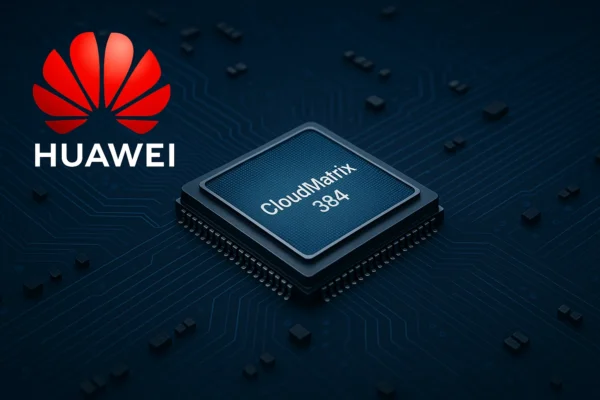
Huawei’s CloudMatrix 384 Supernode, powered by 384 Ascend 910C chips, rivals Nvidia’s GB200 NVL72 with 300 petaflops of AI compute power. Explore its impact on global AI and China’s tech self-sufficiency.
Huawei Technologies has introduced the CloudMatrix 384 Supernode, a groundbreaking AI infrastructure architecture designed to compete with Nvidia’s flagship GB200 NVL72 system. Launched in April 2025, this system leverages 384 Ascend 910C chips to deliver 300 petaflops of dense BF16 compute power—nearly double the 180 petaflops of Nvidia’s NVL72. This development marks a significant step in China’s pursuit of semiconductor self-sufficiency amid US sanctions, addressing critical bottlenecks in AI model training and positioning Huawei as a formidable player in the global AI hardware landscape.
Technical Innovation and System Design:
The CloudMatrix 384 Supernode stands out for its system-level engineering, prioritizing scale and connectivity over individual chip performance. Unlike Nvidia’s GPU-centric approach, Huawei employs an all-to-all topology, connecting 384 Ascend 910C chips through advanced optical interconnects rather than traditional copper links. This design yields:
3.6x Higher Memory Capacity: 49.2TB of HBM versus Nvidia’s 13.8TB.
2.1x Greater Memory Bandwidth: 1.5TB/s compared to Nvidia’s 0.7TB/s.
High Throughput: 1,920 tokens per second for large language model inference, matching Nvidia’s H100 performance.
While the Ascend 910C chip, produced on SMIC’s 7nm process, offers approximately one-third the performance of Nvidia’s H100, Huawei compensates by deploying five times more chips per rack. This approach, while effective, results in a significant drawback: the CloudMatrix consumes 3.9x more power (559 kW versus Nvidia’s 145 kW), making it less efficient per FLOP. However, China’s abundant and affordable energy infrastructure—electricity prices dropped to $56/MWh in 2025 from $90.70/MWh in 2022—mitigates this concern domestically.
Navigating Sanctions and Supply Chain Challenges:
Huawei’s ability to produce the Ascend 910C despite US restrictions on advanced EUV lithography is notable. The chip integrates HBM2E memory, reportedly sourced from Samsung via intermediaries, and relies on TSMC for 2.9 million dies in 2024-2025, enough for 1.05 million Ascend 910C units. SMIC’s expanding 7nm capacity, nearing 50,000 wafers per month, supports domestic production, though yield rates remain around 50%, lagging behind industry leaders. These supply chain maneuvers, including alleged sanction circumventions, have drawn US. scrutiny, with TSMC facing potential fines.
The Ascend 910B, the predecessor, powers roughly 50% of China’s top large language models, but production shortages limited deliveries—ByteDance received only 30,000 of 100,000 ordered chips by mid-2024. The 910C aims to address these constraints, with Huawei securing $2 billion in initial orders, signaling strong domestic demand.
Market Impact and Strategic Advantages:
The CloudMatrix 384 challenges Nvidia’s 90% share of China’s $7 billion AI chip market by offering:
Localized Ecosystem: Integration with Chinese AI frameworks like Zhipu AI and DeepSeek-R1, supported by partnerships with SiliconFlow.
Cost Benefits: Avoiding US tariffs and export controls on Nvidia’s H-series chips, including the H20, banned in April 2025.
5G-Advanced Integration: Huawei’s AI-optimized 5G networks, rolled out in 2025, enhance mobile AI with 10x faster uplink speeds and 30% better operational efficiency.
However, challenges persist. The 7nm Ascend 910C trails Nvidia’s 4nm chips, and Huawei’s software ecosystem requires 2-3x more developer effort compared to Nvidia’s CUDA platform. These gaps may limit global adoption, though domestic momentum is strong.
Strategic Vision and Global Implications:
Huawei’s CloudMatrix 384 is part of a broader strategy to build an AI-native ecosystem. At MWC Barcelona 2025, executives outlined plans for an “Agentic Core” by 2026, leveraging digital twin simulations for self-optimizing networks. Collaborations with ByteDance, Baidu, and China Mobile aim to create a Western-independent AI stack.
Globally, Huawei’s progress signals a bifurcating AI market. US sanctions, including the April 2025 H20 chip ban, have inadvertently accelerated China’s domestic innovation, with analysts predicting Huawei will capture significant market share in China. Nvidia’s CEO Jensen Huang acknowledged this shift, noting Chinese firms are “switching to Huawei” post-ban.
Huawei’s CloudMatrix 384 Supernode underscores China’s determination to achieve AI hardware independence despite geopolitical constraints. While its power-intensive design and reliance on global supply chains pose challenges, the system’s scale, integration with 5G, and domestic ecosystem support make it a credible rival to Nvidia’s offerings. For industry stakeholders, this development highlights the need to reassess export policies and invest in next-generation computing architectures to stay competitive in an increasingly fragmented AI landscape.






